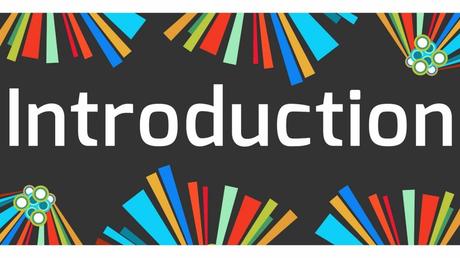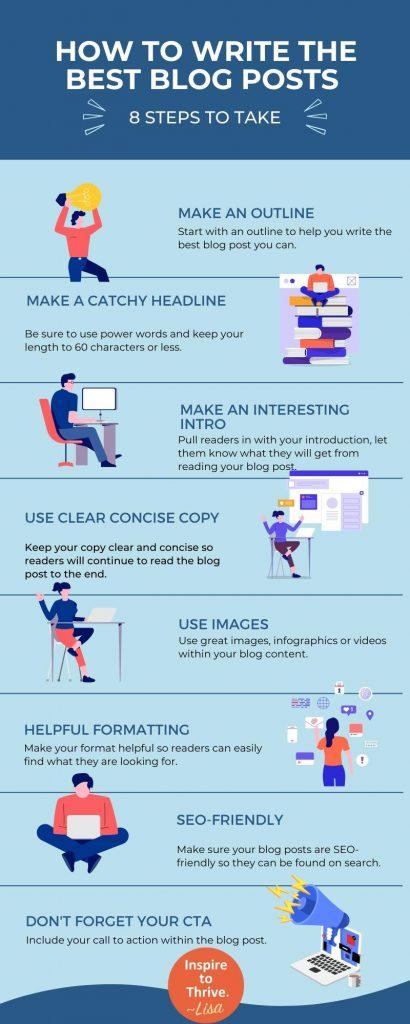
Are you a blogger who feels like you’re stuck in a rut, writing blog post after blog post with no one taking notice? Or maybe you’re a new blogger who’s wondering how to get started. You will learn how to write blog posts that get noticed and read here today starting with how to write a blog post outline.
As a blogger, it can be difficult to get noticed. There are millions of blogs out there, and it can be hard to stand out from the crowd. But don’t despair! However, there are some things you can do to increase your chances of getting noticed.
Whenever I update an old blog post, I change the headline and make them more captivating. This blog post is being updated from back in 2014. It’s a total revamp!
 Learn how to write better blog posts that will get noticed.
Learn how to write better blog posts that will get noticed.
Follow these blogging tips below, and you’ll be on your way as you learn how to write blog posts that readers will love.
1. How To Write A Blog Post Outline To Get Started
Have you ever wanted to start a blog but didn’t know where to begin? Or maybe you have a blog but you’re struggling with writer’s block. Either way, creating a blog post outline can be a helpful way to get your thoughts down on paper (or screen).
By brainstorming a list of ideas and then organizing them into an outline, you’ll have a roadmap to follow as you write your blog post. Not sure how to get started?
Here’s a quick and easy guide on how to create a blog post outline to get you started.
Blog Topics
First, come up with a list of potential topics for your blog post. This can be anything that’s on your mind – there are no wrong answers here. Once you have a few ideas, it’s time to start narrowing them down. Think about what you want your blog post to be about.
What are you trying to say? What kind of tone do you want to set? After you’ve considered these questions, choose one topic and stick with it.
 Pick some hot topics to start your blog outline.
Pick some hot topics to start your blog outline.
Points To Make
Next, it’s time to start thinking about what points you want to include in your blog post. Again, there are no wrong answers here – just let your thoughts flow. Once you have a good amount of material, start organizing it into an outline. A typical blog post outline might look something like this:
– Introduction
– #1 Main point
– #2 Main point
– #3 Main point
– Conclusion
Of course, you don’t have to follow this exact format – feel free to get creative and customize your outline to fit your needs.
The important thing is that each section has a purpose and that each point ties back into your overall topic.
By taking the time to create an outline before you start writing, you’ll save yourself time and effort in the long run. So if you’re feeling stuck, don’t hesitate to give this method a try.
2. How to Write Blog Posts By Starting With A Catchy Headline
Your headline is the first thing potential readers will see, so make sure it’s something that will pique their interest and make them want to read more. A good rule of thumb is to keep your headlines under 60 characters so that they’re easy to read and digest.
Be sure to include power words in your headlines and use numbers as well.
Some power words for you to use:
- Absolutely
- Awe-Inspiring
- Best
- Bold
- Calm
- Caution
- Dazzling
- Deadly
- Easy
- Emergency
See the power word pattern? You can view the entire list in the link above (include power words.) I like referring to that list every time I update or make a new headline.
Not sure if your headline is the right length? You can use this free headline tool to check it out. It’s one of my favorite blogging tools.
3. Make Your Introduction Interesting
Your introduction should be interesting enough to make people want to keep reading. A good way to do this is to start with a story or an anecdote that will hook your readers and make them want to know more.
Not only that but be sure to let the readers know what they will learn or get by reading your blog post. Stick to the headline and first paragraph as you write your blog post.
 Make your blog introduction in your post interesting and stand out.
Make your blog introduction in your post interesting and stand out.
4. How To Write Blog Posts in a Clear, Concise, and Easy-To-Read Style
No one wants to wade through dense paragraphs of text. Breaking your text up into smaller paragraphs makes it easier for people to scan and skim, which means they’re more likely to stick around until the end.
If you use an SEO plugin like Yoast or RankMath they will guide you if you write lengthy sentences.
Therefore, it’s best to break down those lengthy sentences into smaller concise ones.
5. Use Images, Infographics, and Videos
People are visual creatures, so adding visual elements to your posts can help break up the text and make your posts more engaging. Adding an infographic or a video is also a great way to add value for your readers.
 Add visuals to make your blog posts stand out.
Add visuals to make your blog posts stand out.
Not only that but visuals will help spread your content further on social media and on other networks.
6. Use Helpful Formatting Features
Formatting features like headings, lists, and block quotes can also help break up your text and make your posts more scannable. No one wants to read long, never-ending blog posts that are hard to read.
This formatting feature also helps highlight the most important points in your post so that readers can easily find the information they’re looking for.
7. How To Write SEO-Friendly Blog Posts
Make sure you’re using keywords throughout your post so that people can easily find it when they search for topics related to what you’ve written about. You should also include links to other articles or websites where appropriate.
Not only that it will direct readers to additional resources if they want more information on a particular topic.
Furthermore, if you use a plugin tool like Yoast or Rank Math it will help check the SEO of your blog posts. I’ve been using Yoast for years with success and recently using Rank Math on a new blog. I was very surprised at how much I love Rank Math! (Stay tuned!)
Last but not least, do research on your choice of keywords. You want to be sure there are people searching for what you are writing about. I use Ubersuggest and Google Trends to research keywords. Don’t forget about those longer keywords often called long-tail keywords. These keywords tend to rank better in search engines as there is often less competition.
8. Add A Call To Action on Your Blog Posts
If you’re running a blog, it’s important to add a call to action (CTA) to each of your blog posts. A CTA is a statement or task that encourages your readers to take some desired action.
For example, you might add a CTA at the end of a blog post asking your readers to subscribe to your blog, try out a trial product, or leave a comment.
By adding CTAs to your blog posts, you can encourage your readers to take the next step in their relationship with you or your business. And that next step could be anything from signing up for your email list to making a purchase.
So don’t forget to include CTAs on your blog posts – they could be the key to growing your blog and achieving your business goals.
Conclusion of How To Write Blog Posts
Writing blog posts that will get noticed takes some effort, but it’s definitely worth it if you want to grow your blog and attract more readers. By following the tips above, you’ll be well on your way to writing posts that people will actually want to read!
What tip do you like the best on how to write blog posts to get noticed by your readers? Is learning how to write a blog post outline helpful to you? Please drop a comment so we can discuss it!

